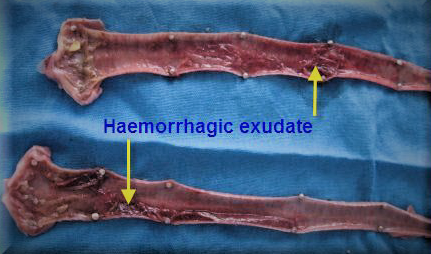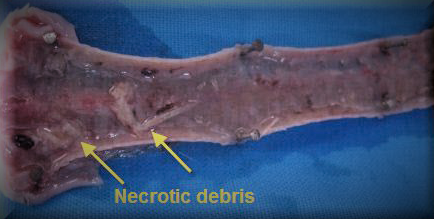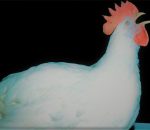Infectious laryngotracheitis is a highly contagious acute to peracute disease of chickens characterized by severe dyspnoea, coughing, expectoration of bloody exudates, and necrotic laryngitis or tracheitis.
ILT is caused by avian alpha-herpesvirus. This alpha herpes virus is enveloped, DNA containing the cubic-shaped virus. it is also sensitive to lipid solvents. ILT virus strains are antigenically homogenous and they may show a marked variation in their virulence. The virus of ILT is very resistant to its survival in the environment. It can survive for 8-10 days in droppings at 10-23 degrees Celsius. Also, it can survive for 10-100 days at ambient temperatures (13-23 degrees Celsius) in tracheal exudates and chicken carcasses. The virus is destroyed in 10-15 minutes at 5 degrees Celsius.
Transmission
- Recovered birds behave as a carrier of disease and continue to excrete virus for as long as two years hence the occasional recurrence of disease is usually observed. Purchased sick and carrier animals are the most important spreading factor.
- Placing of healthy birds in the premises recently evacuated by infected birds is also a source of disease transmission.
- Transmission of this viral disease is documented to spread through wind dispersal over 3km.
- Vertical transmission is not reported in ILT
- Transmission of ILT also occurs through mechanical carriage of infective objects like broken eggs, feathers, and feaces.
- Virus is shed in large amounts from the nose and eyes of affected birds and it spreads through bird to bird contact and contact with contaminated droppings or respiratory tract secretions.
Clinical signs of Infectious laryngotracheitis
The severity of clinical signs varies from very mild to extremely severe.
- Asymptomatic from of disease goes unnoticed with negligible egg loses or mortality.
- Once the disease enters a flock, within one to two weeks, almost all the birds are infected.
- Most signs are prominent in birds at night.
Clinically, the disease is classified in three forms.
Peracute (severe) form
- Sudden onset and rapid spread occur through the flock. birds may die without showing signs.
- Coughing
- Sneezing
- Sudden dyspnoea
- Open mouth breathing
- Gasping
- Wheezing and whistling sounds
- Open beak inhalation (trachea is partially occuluded).
- Coughing of blood stained mucus
- Cyanotic head
- Death occurs due to dyspnoea within 1-3 days.
- The mortality rate usually exceeds 50%.
Subacute form
In this form, respiratory signs extend over a period of some days (3-4) before death. Clinical signs are listed as
- Nasal discharge with sinusitis
- Slight coughing
- Swelling of infraorbital sinuses
- Lacrimation and conjunctivitis
- Haemorrhagic conjunctivitis may lead to temporary blindness or permanent cataract
- Dyspnea is not as sudden or as severe as in the peracute form.
- Mortality is about 10-30%.
Mild form
The mild form of this disease is indistinguishable from other mild respiratory infections such as Infectious Bronchitis.
In this mild form, the onset of illness and morbidity is lower.
- Loss of appetite
- Depression
- Weight loss occurs
- Egg production is also diminished.
Postmortem lesions of ILT
- Conjunctivitis
- Ocular oedema in mild form
- Mucoid tracheitis
- Mild congestion of trachea and larynx is present
- Mucoid to haemorrhagic tracheitis

- Tracheal necrosis and desquamation of epithelium may occur
- Sometimes, diptheric membrane may be present
- Lungs are either normal or show congestion
- Air sacculitis may be seen in some cases

Differential diagnosis
- Infectious bronchitis
- In IB both upper and lower respiratory tracts are damaged but in ILT, lesions are seen only in the upper respiratory tract.
- IB has much more effect on egg production, egg quality and it shows higher mortality than ILT. Loss of egg color and deteriorated shall quality are not considered as a factor in ILT.
- Newcastle disease
- Mortality rate is high in ND than in ILT
- All birds are affected with ND and IB within 24 hours while ILT spreads slowly through a flock.
- Abnormal eggs, higher mortality and proventriculitis are more suggestive of ND.
- The diptheric form of fowl pox with respiratory signs of difficult breathing and gasping may also be mistaken for ILT
- Infectious Coryza
- Bloody tracheitis is typical in ILT while it is unusual in coryza.
- Excessive ammonia
- Avitaminosis
Prevention and control of ILT
- Maintain good sanitary procedures and implement strict biosecurity measures.
- Eradication of virus is a challenging process from multi-age sites because of carrier state.
- Do not mix the recovered and vaccinated birds with healthy or susceptible birds.
- ILT vaccines increase in virulence by bird to bird passage in the field. In areas, where disease does not occur commonly, vaccination of ILT is strongly discouraged. Broilers are generally vaccinated with CEO (chick embryo origin) vaccine by drinking water only in the face of an outbreak.
- Application of ILT vaccines by eye drop method is more protective than application by water or spray.
Treatment of infectious laryngotracheitis
- Vitamin supplementation
- Antibiotics are offered in water and feed to avoid secondary bacterial infections.
- Anti-inflammatory drugs are used to reduce extensive tracheal damage.


